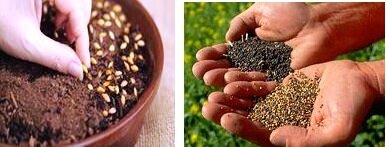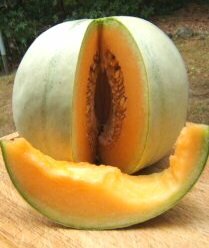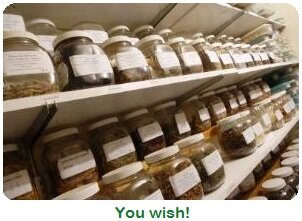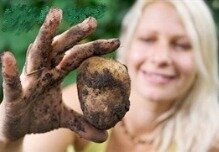Saving and Storing Vegetable Seeds
Watch out! Some have entered the rewarding world of saving seeds and never been heard of again...
Gathering your own seeds, caring for them and replanting helps connect you to the reverent circle of life. You are saving the next generation; you are preserving an age old custom. It's a good feeling.
By all means, delve into this creative pleasure and learn how to save your own seeds from your vegetable garden.
Investigate the following tips on safely storing seeds so that they burst forth to produce new veggies for you each season... But please take heed, it is addictive!
Nature has complicated systems — but here is some basic information that is handy to know when you are saving and storing seeds.
Perfect and Imperfect Flowers
For plants to reproduce, both male and female functions need to get together for pollination or fertilization.
Perfect Flowers — also called Complete Flowers or Hermaphrodites

Some plants are self-pollinating and have what we call, perfect flowers which have male and female parts in each flower. Ninety-five percent of the time they produce pure offspring with the same characteristics as the parent plant.
Peas, beans, tomatoes, lettuce, chicory, endive and okra are the best know vegetables with perfect flowers.
These plants don't cross-pollinate with other varieties of the same genus species, so you can safely grow different varieties of them all cuddled up in the same garden. You can save their seeds, knowing these seeds will breed true.
Imperfect Flowers— also called Incomplete Flowers
Most of the other vegetables have imperfect flowers. This means each flower only has one set of reproductive organs, either male or female. The male flower has a stamen and the female flower has the gynoecium or ovum.
The sex is now up to the randomness of visiting bees, wind, insects and other passerbys to carry pollen from a male flower and deposit on the ovary of a female flower.
Within these two main flower groups there is more diversity, such as some plants have perfect flowers, but need another plant with perfect flowers to propagate. Some plants have only male or female imperfect flowers, and some have both, and so on.
Do your research if you want to really bone up on plant reproduction, otherwise follow what works for you and your gardening friends in your area with your plant varieties.
But you can see how easily it is for cross-pollination to occur. Pollen from a male flower of one variety, say, squash, ends up pollinating the female flower of a different variety – and hey ho, a new variety or hybrid is born.

That's why gardeners have wondered why seeds saved from last year, produced something different, often some little, tasteless ne'er do well.
Even though some plants have imperfect flowers, they rarely cross-pollinate with each other, but with plants that are frequently liable to cross-pollinate, there are isolating distances needed when planting.
A general guide is to separate varieties of the same species by a minimum of 150m (500ft), although some need a few miles... as far as the local bees fly or the wind blows.
Many home gardeners take a middle of the road stance and put these plants at opposite ends of their garden, from a few feet to 200ft apart. It's a wink and a nod in the right direction and it all helps.
How to stop cross pollination:

- Stick to One: Best is to only grow one variety of each species each year. For full season crops, only plant one variety of each, such as pumpkin, one of cucumber, one chilli, one watermelon, one honeydew and so on.
- Staggered Planting Times: Grow an early season variety followed by a main or late season kind. For example, plant early corn, then 3 weeks later plant main crop corn.
-
Isolate the flowers: Mainly from cabbage, corn, pumpkin, and in particular the cucurbit family. Watch out for the wayward cross pollinating of certain cucurbit vines like cucumbers, courgettes/zucchini, melons and pumpkins.
These promiscuous vines of the cucurbit family can run rampant behind your back and before you know it their mix and match habits have produced some weird mutant fruits.
So to stop this happening, and to save the seeds of a particular strain, it is best to grow only one type of cucurbit each season. But to make doubly sure of success, you need to pollenate the female flower with pollen from a male flower by hand and keep the bees away by tying the top of the female flower together with a soft rubber band, soft cloth or strip of panty hose.
You can also loosely tie a paper or plastic bag with pinprick holes over each flower once you have hand-pollinated it.
- Grow heirloom seeds: Read why these seeds don't cross pollinate.
But in truth, most of the seed saving gardeners I know, don't concern themselves about the odd maverick vegetable and just love saving seeds.
The odds are more in our favour for pure reproduction. There's always the possibility of a super-duper hybrid appearing!
Saving Vegetable Seeds

There are a good many ways for gardeners to save seeds of most vegetables. Try your hand at these...
For most root and leafy plants:
- Stop watering plants once seed heads have formed
- Tie or stake seed plants so they don't keel over and ruin the seeds.
- Collect the seeds once the seed stalks, heads or umbels have changed colour, usually from green to yellow to brown. Don't pick too early before they are ready, but don't leave it too late for weather, insects or birds to ruin them
- Cut or break off the seed head or stalk and put into an unwaxed paper bag. No need to seal, just close loosely. Some seed heads burst open, that's why a bag is handy.
- Put the bag in a warm place. A warmish dry room is fine, as long as no dampness occurs there. It will take an average of one week to dry properly. (Once your seeds are dried and stored, they'll need a COOL place).
- Once the seeds are completely dry, hold the bag at the top tightly and shake well. This will separate the seeds off their stalks or seed heads.
- Tip out of the bag and store seeds in an airtight container.
- If you don't use a paper bag, hang upside down over paper or something to catch the seeds, or spread seed heads out on newspaper and leave to dry as in above conditions. (Don't blame me if they burst everywhere or you knock them and scatter them asunder!)
For vine plants such as tomatoes, eggplants, cucurbits etc:
- The fruits need to be left to get ripe on the vine, in fact over ripe so that the seeds are fully formed, but not starting to rot.
- Wait until green cucumbers go yellow, and marrows and melons go dull and tough-skinned.
- Pick fruit, cut open and extract seeds. Wash or rub off any remaining flesh, then spread out on paper to dry thoroughly before storing in airtight containers.

- For tomatoes and potatoes or other seeds that have a definite gel sac surrounding each seed, it helps to do something rotten. Remove most of the flesh and then ferment them, thereby mimicking nature and rotting them.
So instead of a tomato rotting away on the ground, they are now rotting under your watchful eye. Here's how to do this...
-
- Cover seeds with twice as much water in a bowl or jar.
- Cover loosely to stop the odour... phew, and leave the seeds in a nice warm spot to ferment, stirring each day, for about 2-4 days.
- The good seeds will sink and the gel will float to the top and form a mould layer.
- Pour off all this mess, rinse and pour, rinse and pour until there are only your sparkling clean seeds left. Pour into strainer and drain.
- Dry as quickly as you can, either in the strainer or on paper or a plate. Paper has a habit of causing seeds to cling to it, so keep moving them around if possible.
- Don't dry in direct sun, just a warm, dry spot, and keep turning and separating any clumpy bits. It should take from 3-6 days, then seal and store.
NOTE: As soon as the fermentation process is done, that is, the water surface is covered with the gel mould, you need to do the remove, rinse and dry process.
Why? Because the gel has growth inhibitors and once that has fermented away and there are warm, moist conditions, your seeds might germinate.
Of course, you don't have to do this fermentation process; it's just that it increases the odds of successful seed saving. Likewise you can just let a rotten tomato roll into the corner of your garden or toss one in the glasshouse and chances are that lots of seedlings will emerge in the warm weather.
When it comes to saving seeds, I suspect most gardeners, like me, do a bit of everything... controlled and natural abandonment...and how exciting to find all sorts of seedlings of all sorts of vegetables appearing in all sorts of places!
How do you tell if your saved seeds are dry enough to store?
It's pretty hard to over-dry seeds, unless you use an oven or microwave, which is a definite no, no.
For larger seeds, snap a seed in half. If it won't snap and just bends, dry for a few more days.
Or, put a seed on a hard surface and try and snap it with an ordinary dinner knife (not a sharp kitchen or pocket knife). In fact your fingernail will do. If the seed just dents or bends, keep drying.
Here's how to store vegetable seeds
Storing Seeds:
- Remember cool and dry... that's how seeds need to be stored, otherwise they might sprout. Basement, shed, garage, cupboards in cool rooms, refrigerator (warmest part, particularly crisper, but definitely not near or in freezer).
- Just about any container can be used to store seeds. Plastic or glass jars, metal containers with good lids.
- Envelopes that seal are okay and very handy to store and write on, but best to then put them into a larger lidded container or plastic bag.
- Paper and newspaper make makeshift envelopes. Wrap your seeds up and then seal up in the same way as seeds in envelopes.
- It helps, and particularly for long storage to use a desiccant or wicking agent to absorb moisture. This can go in with the seeds, but if you have an outermost container or bag holding a number of seed packets, put the desiccant in this outer storage. Suggestions...
-
- Those little silica packs from the likes of vitamin containers, foodstuff packets, and shoe boxes are good to use
- Rice grains, uncooked
- Milk powder wrapped in tissue paper. Approximately use 2-3 tissues and 1-2 tablespoons of powder well folded up in the tissues. This will keep dry a number of packets in one outer bag or container
- Make sure the envelopes, paper and desiccants you use are really dry first. Give them a sunbathe or a couple of hours in a low oven before using
- Write on the names, dates and any other details BEFORE you put in the seeds... much easier. If it's not possible to write on a container, use a label
- When removing stored seeds from fridge, let them come to room temperature before you open container. This stops any risk of condensation from the air making your seeds moist and sticking together.
How long do seeds last?
- 5 or more years: Cruciferous vegetables (such as, broccoli, cabbage, cauliflower, collards etc.), cucumber, kale, lettuce, most melons, mustard, peppers, radish, swede, tomato (up to 10 years), turnip
- 3-5 years: Beans, carrot, celery, chard, eggplant, parsley, peas, pumpkin, squash, watermelon
- 1-2 years: Leek, onion, parsnip, sweetcorn, spinach
For more information on Seeds and Seedlings, follow these links below:
Vegetable Seedlings: How and why to grow your own vegetable seeds
Seed Varieties & Products: Types of Vegetable Seeds
Starting Seedlings Indoors: How to Give your Vegetable Seeds a Head Start
Vegetable Sowing Guides: Seed Sowing Guides for different Climate Regions
Germination Guide: Times for Seeds to Sprout, Stratification, Scarification & Chitting of Seeds
Heirloom Seeds Recommended sellers of a huge range of economical non-hybrid seeds — US & Canada.

YES! You can successfully grow potatoes from your own seed; find out now with this popular guide: The Truth About Growing Magnificent Potatoes







